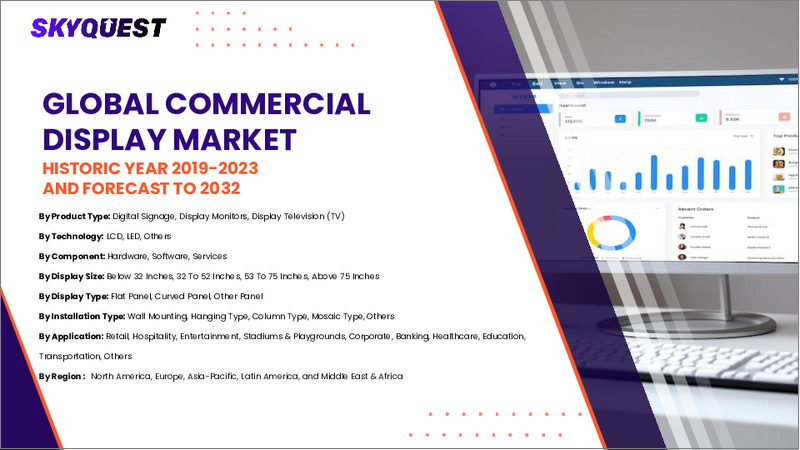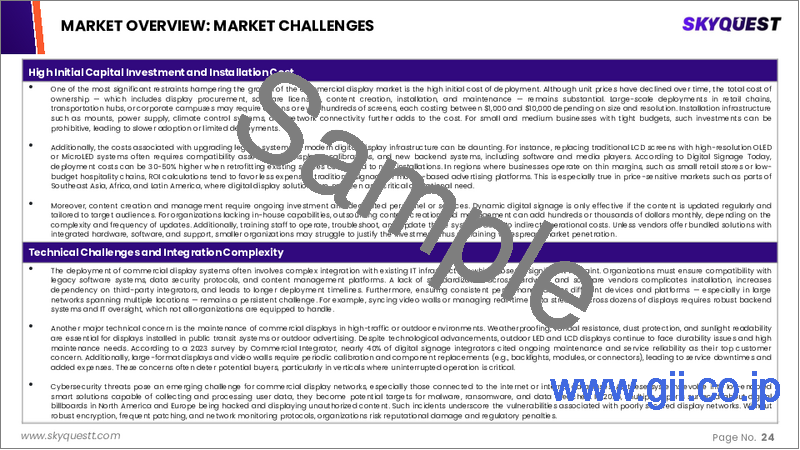|
|
市場調査レポート
商品コード
1636900
業務用ディスプレイの市場規模、シェア、成長分析:製品別、技術別、コンポーネント別、タイプ別、サイズ別、用途別、地域別 - 産業予測 2025~2032年Commercial Display Market Size, Share, Growth Analysis, By Product (Digital Signage, Display Monitor), By Technology (LCD, LED), By Component, By Type, By Size, By Application, By Region - Industry Forecast 2025-2032 |
||||||
|
|||||||
| 業務用ディスプレイの市場規模、シェア、成長分析:製品別、技術別、コンポーネント別、タイプ別、サイズ別、用途別、地域別 - 産業予測 2025~2032年 |
|
出版日: 2025年01月15日
発行: SkyQuest
ページ情報: 英文 314 Pages
納期: 3~5営業日
|
全表示
- 概要
- 目次
業務用ディスプレイの世界市場規模は、2023年に583億米ドルと評価され、2024年の620億9,000万米ドルから2032年には1,027億6,000万米ドルに成長し、予測期間(2025-2032年)のCAGRは6.5%で成長する見通しです。
新興諸国における急速な都市化は、インフラの改善と消費者のライフスタイルの進化に牽引され、商業セクターの成長に拍車をかけています。小売業や接客業では、商品やサービスの認知度を高めるため、先進的なデジタル・マーケティング戦略の採用が進んでいます。この動向は、AIアップスケーリングや機械学習などの技術によってさらに推進される、特に4Kや8Kモデルなどの業務用ディスプレイの需要を大幅にエスカレートさせています。広告業界では、高価なUHD制作機による制約から脱却し、超HDコンテンツ制作が顕著に増加しています。このようなUHDコンテンツ開発の急増は、様々な広告用途における高解像度ディスプレイの需要に拍車をかけています。さらに、エネルギー効率の高いハイスペック製品へのメーカーによる多額の投資が、市場の成長をさらに刺激すると予想されます。
目次
イントロダクション
- 調査の目的
- 調査範囲
- 定義
調査手法
- 情報調達
- 二次データと一次データの方法
- 市場規模予測
- 市場の前提条件と制限
エグゼクティブサマリー
- 世界市場の見通し
- 供給と需要の動向分析
- セグメント別機会分析
市場力学と見通し
- 市場概要
- 市場規模
- 市場力学
- 促進要因と機会
- 抑制要因と課題
- ポーターの分析
主な市場の考察
- 重要成功要因
- 競合の程度
- 主な投資機会
- 市場エコシステム
- 市場の魅力指数(2024年)
- PESTEL分析
- マクロ経済指標
- バリューチェーン分析
- 価格分析
- 技術分析
業務用ディスプレイ市場規模:製品別& CAGR(2025-2032)
- 市場概要
- デジタルサイネージ
- ビデオウォール
- ビデオスクリーン
- 透明LEDスクリーン
- デジタルポスター
- 電子ペーパー
- キオスク
- その他
- ディスプレイモニター
- ディスプレイテレビ
業務用ディスプレイ市場規模:技術別& CAGR(2025-2032)
- 市場概要
- 液晶
- LED
- ミニLED
- マイクロLED
- その他のLED
- その他
業務用ディスプレイ市場規模:コンポーネント別& CAGR(2025-2032)
- 市場概要
- ハードウェア
- ソフトウェア
- サービス
業務用ディスプレイ市場規模:タイプ別& CAGR(2025-2032)
- 市場概要
- フラットパネル
- 曲面パネル
- その他のパネル
業務用ディスプレイ市場規模:サイズ別& CAGR(2025-2032)
- 市場概要
- 32インチ以下
- 32~52インチ
- 52~75インチ
- 75インチ以上
業務用ディスプレイ市場規模:用途別& CAGR(2025-2032)
- 市場概要
- 小売り
- ホスピタリティ
- エンターテインメント
- スタジアムと遊び場
- 企業
- 銀行業務
- ヘルスケア
- 教育
- 交通機関
業務用ディスプレイ市場規模:地域別& CAGR(2025-2032)
- 北米
- 米国
- カナダ
- 欧州
- ドイツ
- スペイン
- フランス
- 英国
- イタリア
- その他欧州地域
- アジア太平洋地域
- 中国
- インド
- 日本
- 韓国
- その他アジア太平洋地域
- ラテンアメリカ
- ブラジル
- その他ラテンアメリカ地域
- 中東・アフリカ
- GCC諸国
- 南アフリカ
- その他中東・アフリカ
競合情報
- 上位5社の比較
- 主要企業の市場ポジショニング(2024年)
- 主な市場企業が採用した戦略
- 市場の最近の動向
- 企業の市場シェア分析(2024年)
- 主要企業の企業プロファイル
- 会社概要
- 製品ポートフォリオ分析
- セグメント別シェア分析
- 収益の前年比比較(2022-2024)
主要企業プロファイル
- Samsung Electronics Co., Ltd.(South Korea)
- LG Display Co., Ltd.(South Korea)
- Sharp Corporation(Japan)
- BOE Technology Group Co., Ltd.(China)
- Sony Group Corporation(Japan)
- Panasonic Holdings Corporation(Japan)
- NEC Corporation(Japan)
- Koninklijke Philips N.V.(Netherlands)
- Leyard Optoelectronic Co., Ltd.(China)
- Daktronics, Inc.(USA)
- Planar Systems, Inc.(USA)
- Christie Digital Systems USA, Inc.(USA)
- Barco NV(Belgium)
- Dell Technologies Inc.(USA)
- HP Inc.(USA)
- Cisco Systems, Inc.(USA)
- Innolux Corporation(Taiwan)
- AUO Corporation(Taiwan)
- E Ink Holdings Inc.(Taiwan)
- Tianma Microelectronics Co., Ltd.(China)
結論と推奨事項
Global Commercial Display Market size was valued at USD 58.3 billion in 2023 and is poised to grow from USD 62.09 billion in 2024 to USD 102.76 billion by 2032, growing at a CAGR of 6.5% during the forecast period (2025-2032).
The rapid urbanization in developing countries is catalyzing growth in the commercial sector, driven by infrastructure improvements and evolving consumer lifestyles. Retail and hospitality sectors are increasingly adopting advanced digital marketing strategies to enhance product and service visibility. This trend is significantly escalating the demand for commercial displays, notably 4K and 8K models, which are further propelled by technologies like AI upscaling and machine learning. The advertising industry is witnessing a remarkable increase in ultra-HD content creation, transitioning from prior limitations of costly UHD-producing machines. This surge in UHD content development is fueling the demand for high-resolution displays in various advertising applications. Additionally, significant investments by manufacturers in energy-efficient, high-spec products are expected to further stimulate market growth.
Top-down and bottom-up approaches were used to estimate and validate the size of the Global Commercial Display market and to estimate the size of various other dependent submarkets. The research methodology used to estimate the market size includes the following details: The key players in the market were identified through secondary research, and their market shares in the respective regions were determined through primary and secondary research. This entire procedure includes the study of the annual and financial reports of the top market players and extensive interviews for key insights from industry leaders such as CEOs, VPs, directors, and marketing executives. All percentage shares split, and breakdowns were determined using secondary sources and verified through Primary sources. All possible parameters that affect the markets covered in this research study have been accounted for, viewed in extensive detail, verified through primary research, and analyzed to get the final quantitative and qualitative data.
Global Commercial Display Market Segmental Analysis
Global Commercial Display Market is segmented by Product, Technology, Component, Type, Size, Application and Region. Based on Product, the market is segmented into Digital Signage, Display Monitor and Display TVs. Based on Technology, the market is segmented into LCD, LED and Others. Based on Component, the market is segmented into Hardware, Software and Services. Based on Type, the market is segmented into Flat Panel, Curved Panel and Other Panel. Based on Size, the market is segmented into Below 32 inches, Between 32 to 52 inches, Between 52 to 75 inches, and Above 75 inches. Based on Application, the market is segmented into Retail, Hospitality, Entertainment, Stadiums & Playgrounds, Corporate, Banking, Healthcare, Education and Transportation. Based on Region, the market is segmented into North America, Europe, Asia Pacific, Latin America and Middle East & Africa.
Driver of the Global Commercial Display Market
The Global Commercial Display market is experiencing significant growth driven by the increasing demand for digitization across various sectors, particularly in healthcare and transportation. This surge is fueled by rapid industrialization, urbanization, and heightened government investment in infrastructure development, alongside evolving consumer lifestyles. Companies are increasingly adopting digital technologies to effectively promote their products and services, making a lasting impact on consumers. Moreover, the integration of advanced technologies such as AI and machine learning within commercial displays enhances their appeal. The emergence of 4K and 8K resolution displays is further elevating the production of ultra-HD marketing content. Additionally, the global push for energy efficiency is leading to a rising demand for sustainable commercial display solutions.
Restraints in the Global Commercial Display Market
Global Commercial Display should prioritize sustainability and environmental responsibility in its operations by reducing energy consumption and minimizing waste throughout the production process. The company must also comply with international regulations and standards governing electronic displays and materials used in manufacturing, ensuring that products are safe and recyclable. Moreover, it should actively engage in ethical labor practices, ensuring fair treatment and compensation for workers across its global supply chain. In response to the rising trend of digital transformation, Global Commercial Display is encouraged to innovate while maintaining transparency and accountability in its business practices, fostering trust with consumers and stakeholders alike.
Market Trends of the Global Commercial Display Market
The Global Commercial Display market is witnessing a transformative trend driven by the rising demand for luxury displays, particularly in the automotive sector. Innovations in emerging technologies, such as autonomous driving and augmented reality, are enhancing the consumer experience and reshaping business models within the industry. The introduction of high-end features, like OLED screens showcased in luxury vehicles by brands such as Mercedes-Benz, highlights a growing preference for sophisticated visual interfaces. This trend not only elevates aesthetic appeal but also integrates advanced functionalities, reinforcing the market's expansion as manufacturers increasingly prioritize cutting-edge display solutions to meet evolving consumer expectations.
Table of Contents
Introduction
- Objectives of the Study
- Scope of the Report
- Definitions
Research Methodology
- Information Procurement
- Secondary & Primary Data Methods
- Market Size Estimation
- Market Assumptions & Limitations
Executive Summary
- Global Market Outlook
- Supply & Demand Trend Analysis
- Segmental Opportunity Analysis
Market Dynamics & Outlook
- Market Overview
- Market Size
- Market Dynamics
- Drivers & Opportunities
- Restraints & Challenges
- Porters Analysis
- Competitive rivalry
- Threat of substitute
- Bargaining power of buyers
- Threat of new entrants
- Bargaining power of suppliers
Key Market Insights
- Key Success Factors
- Degree of Competition
- Top Investment Pockets
- Market Ecosystem
- Market Attractiveness Index, 2024
- PESTEL Analysis
- Macro-Economic Indicators
- Value Chain Analysis
- Pricing Analysis
- Technology Analysis
Global Commercial Display Market Size by Product & CAGR (2025-2032)
- Market Overview
- Digital Signage
- Video Walls
- Video Screens
- Transparent LED Screens
- Digital Posters
- ePaper
- Kiosks
- Others
- Display Monitor
- Display TVs
Global Commercial Display Market Size by Technology & CAGR (2025-2032)
- Market Overview
- LCD
- LED
- Mini LED
- Micro LED
- Other LED
- Others
Global Commercial Display Market Size by Component & CAGR (2025-2032)
- Market Overview
- Hardware
- Software
- Services
Global Commercial Display Market Size by Type & CAGR (2025-2032)
- Market Overview
- Flat Panel
- Curved Panel
- Other Panel
Global Commercial Display Market Size by Size & CAGR (2025-2032)
- Market Overview
- Below 32 inches
- Between 32 to 52 inches
- Between 52 to 75 inches
- Above 75 inches
Global Commercial Display Market Size by Application & CAGR (2025-2032)
- Market Overview
- Retail
- Hospitality
- Entertainment
- Stadiums & Playgrounds
- Corporate
- Banking
- Healthcare
- Education
- Transportation
Global Commercial Display Market Size & CAGR (2025-2032)
- North America (Product, Technology, Component, Type, Size, Application)
- US
- Canada
- Europe (Product, Technology, Component, Type, Size, Application)
- Germany
- Spain
- France
- UK
- Italy
- Rest of Europe
- Asia Pacific (Product, Technology, Component, Type, Size, Application)
- China
- India
- Japan
- South Korea
- Rest of Asia-Pacific
- Latin America (Product, Technology, Component, Type, Size, Application)
- Brazil
- Rest of Latin America
- Middle East & Africa (Product, Technology, Component, Type, Size, Application)
- GCC Countries
- South Africa
- Rest of Middle East & Africa
Competitive Intelligence
- Top 5 Player Comparison
- Market Positioning of Key Players, 2024
- Strategies Adopted by Key Market Players
- Recent Developments in the Market
- Company Market Share Analysis, 2024
- Company Profiles of All Key Players
- Company Details
- Product Portfolio Analysis
- Company's Segmental Share Analysis
- Revenue Y-O-Y Comparison (2022-2024)
Key Company Profiles
- Samsung Electronics Co., Ltd. (South Korea)
- Company Overview
- Business Segment Overview
- Financial Updates
- Key Developments
- LG Display Co., Ltd. (South Korea)
- Company Overview
- Business Segment Overview
- Financial Updates
- Key Developments
- Sharp Corporation (Japan)
- Company Overview
- Business Segment Overview
- Financial Updates
- Key Developments
- BOE Technology Group Co., Ltd. (China)
- Company Overview
- Business Segment Overview
- Financial Updates
- Key Developments
- Sony Group Corporation (Japan)
- Company Overview
- Business Segment Overview
- Financial Updates
- Key Developments
- Panasonic Holdings Corporation (Japan)
- Company Overview
- Business Segment Overview
- Financial Updates
- Key Developments
- NEC Corporation (Japan)
- Company Overview
- Business Segment Overview
- Financial Updates
- Key Developments
- Koninklijke Philips N.V. (Netherlands)
- Company Overview
- Business Segment Overview
- Financial Updates
- Key Developments
- Leyard Optoelectronic Co., Ltd. (China)
- Company Overview
- Business Segment Overview
- Financial Updates
- Key Developments
- Daktronics, Inc. (USA)
- Company Overview
- Business Segment Overview
- Financial Updates
- Key Developments
- Planar Systems, Inc. (USA)
- Company Overview
- Business Segment Overview
- Financial Updates
- Key Developments
- Christie Digital Systems USA, Inc. (USA)
- Company Overview
- Business Segment Overview
- Financial Updates
- Key Developments
- Barco NV (Belgium)
- Company Overview
- Business Segment Overview
- Financial Updates
- Key Developments
- Dell Technologies Inc. (USA)
- Company Overview
- Business Segment Overview
- Financial Updates
- Key Developments
- HP Inc. (USA)
- Company Overview
- Business Segment Overview
- Financial Updates
- Key Developments
- Cisco Systems, Inc. (USA)
- Company Overview
- Business Segment Overview
- Financial Updates
- Key Developments
- Innolux Corporation (Taiwan)
- Company Overview
- Business Segment Overview
- Financial Updates
- Key Developments
- AUO Corporation (Taiwan)
- Company Overview
- Business Segment Overview
- Financial Updates
- Key Developments
- E Ink Holdings Inc. (Taiwan)
- Company Overview
- Business Segment Overview
- Financial Updates
- Key Developments
- Tianma Microelectronics Co., Ltd. (China)
- Company Overview
- Business Segment Overview
- Financial Updates
- Key Developments





